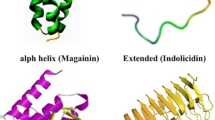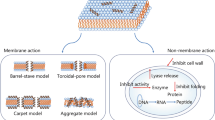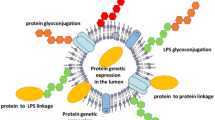Abstract
A variety of Gram-negative pathogens possess host-specific lactoferrin (Lf) receptors that mediate the acquisition of iron from host Lf. The integral membrane protein component of the receptor, lactoferrin binding protein A specifically binds host Lf and is required for acquisition of iron from Lf. In contrast, the role of the bi-lobed surface lipoprotein, lactoferrin binding protein B (LbpB), in Lf binding and iron acquisition is uncertain. A common feature of LbpBs from most species is the presence of clusters of negatively charged amino acids in the protein’s C-terminal lobe. Recently it has been shown that the negatively charged regions from the Neisseria meningitidis LbpB are responsible for protecting against an 11 amino acid cationic antimicrobial peptide (CAP), lactoferricin (Lfcin), derived from human Lf. In this study we investigated whether the LbpB confers resistance to other CAPs since N. meningitidis is likely to encounter other CAPs from the host. LbpB provided protection against the cathelicidin derived peptide, cathelicidin related antimicrobial peptide (mCRAMP), but did not confer protection against Tritrp 1 or LL37 under our experimental conditions. When tested against a range of rationally designed synthetic peptides, LbpB was shown to protect against IDR-1002 and IDR-0018 but not against HH-2 or HHC10.




Similar content being viewed by others
References
Adamiak P, Beddek A, Pajon R, Schryvers AB (2012) Patterns of sequence variation with the Neisseria meningitidis lactoferrin-binding proteins. Biochem Cell Biol 90(3):339–350
Agerberth B, Gunne H, Odeberg J, Kogner P, Boman HG, Gudmundsson GH (1995) FALL-39, a putative human peptide antibiotic, is cysteine-free and expressed in bone marrow and testis. Proc Natl Acad Sci 92(1):195–199
Andrushchenko VV, Vogel HJ, Prenner EJ (2006) Solvent-dependent structure of two tryptophan-rich antimicrobial peptides and their analogs studied by FTIR and CD spectroscopy. Biochimica et Biophysica Acta (BBA) 1758(10):1596–1608
Arnold RR, Russell JE, Champion WJ, Brewer M, Gauthier JJ (1982) Bactericidal activity of human lactoferrin: differentiation from the stasis of iron deprivation. Infect Immun 35:792–799
Arutyunova E, Brooks CL, Beddek A, Mak MW, Schryvers AB, Lemieux MJ (2012) Crystal structure of the N-lobe of lactoferrin binding protein B from Moraxella bovis. Biochem Cell Biol 90(3):351–361
Bellamy W, Takase M, Yamauchi K, Wakabayashi H, Kawase K, Tomita M (1992) Identification of the bactericidal domain of lactoferrin. Biochim Biophys Acta 1121:130–136
Bonnah RA, Schryvers AB (1998) Preparation and characterization of Neisseria meningitidis mutants deficient in the production of the human lactoferrin binding proteins LbpA and LbpB. J Bacteriol 180(12):3080–3090
Bonnah RA, Wong H, Loosmore SM, Schryvers AB (1999) Characterization of Moraxella (Branhamella) catarrhalis lbpB, lbpA and lactoferrin receptor orf3 isogenic mutants. Infect Immun 67(3):1517–1520
Bonnah RA, Yu R-H, Schryvers AB (1995) Biochemical analysis of lactoferrin receptors in the Neisseriaceae: identification of a second bacterial lactoferrin receptor protein. Microb Pathog 19(5):285–297
Bowdish DME, Davidson DJ, Lau YE, Lee K, Scott MG, Hancock REW (2005) Impact of LL-37 on anti-infective immunity. J Leukoc Biol 77(4):451–459. doi:10.1189/jlb.0704380
Breton-Gorius J, Mason D, Buriot D, Vilde J, Griscelli C (1980) Lactoferrin deficiency as a consequence of a lack of specific granules in neutrophils from a patient with recurrent infections. Detection by immunoperoxidase staining for lactoferrin and cytochemical electron microscopy. Am J Pathol 99(2):413
Calmettes C, Alcantara J, Schryvers AB, Moraes TF (2012) The structural basis of transferrin iron sequestration by transferrin binding protein B. Nat Struct Mol Biol 19(3):358–360
Calmettes C, Yu R-H, Silva LP, Curran D, Schriemer DC, Schryvers AB, Moraes TF (2011) Structural variations within the transferrin binding site on transferrin binding protein, TbpB. J Biol Chem 286:12683–12692
Cherkasov A, Hilpert K, Jenssen H, Fjell CD, Waldbrook M, Mullaly SC, Volkmer R, Hancock REW (2009) Use of artificial intelligence in the design of small peptide antibiotics effective against a broad spectrum of highly antibiotic-resistant superbugs. ACS Chem Biol 4(1):65–74
Finlay BB, Hancock RE (2004) Can innate immunity be enhanced to treat microbial infections? Nat Rev Micro 2(6):497–504
Fjell CD, Jenssen H, Hilpert K, Cheung WA, Panté N, Hancock REW, Cherkasov A (2009) Identification of novel antibacterial peptides by chemoinformatics and machine learning†. J Med Chem 52(7):2006–2015
Gallo RL, Kim KJ, Bernfield M, Kozak CA, Zanetti M, Merluzzi L, Gennaro R (1997) Identification of CRAMP, a Cathelin-related Antimicrobial Peptide Expressed in the Embryonic and Adult Mouse. J Biol Chem 272(20):13088–13093
Hancock REW, Lehrer R (1998) Cationic peptides: a new source of antibiotics. Trends Biotechnol 16(2):82–88
Hancock REW, Rozek A (2002) Role of membranes in the activities of antimicrobial cationic peptides. FEMS Microbiol Lett 206(2):143–149
Iimura M, Gallo RL, Hase K, Miyamoto Y, Eckmann L, Kagnoff MF (2005) Cathelicidin mediates innate intestinal defense against colonization with epithelial adherent bacterial pathogens. J Immunol 174(8):4901–4907
Jenssen H, Hamill P, Hancock REW (2006) Peptide antimicrobial agents. Clin Microbiol Rev 19(3):491–511
Jones A, Geörg M, Maudsdotter L, Jonsson AB (2009) Endotoxin, capsule, and bacterial attachment contribute to neisseria meningitidis resistance to the human antimicrobial peptide LL-37. J Bacteriol 191(12):3861–3868
Kindrachuk J, Jenssen H, Elliott M, Townsend R, Nijnik A, Lee SF, Gerdts V, Babiuk LA, Halperin SA, Hancock RE (2009) A novel vaccine adjuvant comprised of a synthetic innate defence regulator peptide and CpG oligonucleotide links innate and adaptive immunity. Vaccine 27(34):4662–4671
Lawyer C, Pai S, Watabe M, Borgia P, Mashimo T, Eagleton L, Watabe K (1996) Antimicrobial activity of a 13 amino acid tryptophan-rich peptide derived from a putative porcine precursor protein of a novel family of antibacterial peptides. FEBS Lett 390(1):95–98
Marcotte I, Wegener KL, Lam Y-H, Chia BCS, de Planque MRR, Bowie JH, Auger M, Separovic F (2003) Interaction of antimicrobial peptides from Australian amphibians with lipid membranes. Chem Phys Lipids 122(1–2):107–120
Martin E, Ganz T, Lehrer RI (1995) Defensins and other endogenous peptide antibiotics of vertebrates. J Leukoc Biol 58(2):128–136
Mayer ML, Blohmke CJ, Falsafi R, Fjell CD, Madera L, Turvey SE, Hancock REW (2013) Rescue of dysfunctional autophagy attenuates hyperinflammatory responses from cystic fibrosis cells. J Immunol 190(3):1227–1238
Morgenthau A, Adamiak P, Livingstone MJ, Schryvers AB (2012) The role of lactoferrin binding protein B in mediating protection against lactoferricin. Biochem Cell Biol 90(3):417–423
Morgenthau A, Beddek A, Schryvers AB (2014) The negatively charged regions of lactoferrin binding protein B, an adaptation against anti-microbial peptides. PLoS One 9(1):e86243
Morgenthau A, Pogoutse A, Adamiak P, Moraes TF, Schryvers AB (2013) Bacterial receptors for host transferrin and lactoferrin: molecular mechanisms and role in host-microbe interactions. Future Microbiol 8(12):1575–1585
Nijnik A, Madera L, Ma S, Waldbrook M, Elliott MR, Easton DM, Mayer ML, Mullaly SC, Kindrachuk J, Jenssen H, Hancock REW (2010) Synthetic cationic peptide IDR-1002 provides protection against bacterial infections through chemokine induction and enhanced leukocyte recruitment. J Immunol 184(5):2539–2550
Nizet V, Ohtake T, Lauth X, Trowbridge J, Rudisill J, Dorschner RA, Pestonjamasp V, Piraino J, Huttner K, Gallo RL (2001) Innate antimicrobial peptide protects the skin from invasive bacterial infection. Nature 414(6862):454–457
Noinaj N, Cornelissen CN, Buchanan SK (2013) Structural insight into the lactoferrin receptors from pathogenic Neisseria. J Struct Biol 184(1):83–92
Roussel-Jazede V, Jongerius I, Bos MP, Tommassen J, van Ulsen P (2010) NalP-mediated proteolytic release of lactoferrin-binding protein B from the meningococcal cell surface. Infect Immun 78(7):3083–3089
Schibli DJ, Nguyen LT, Kernaghan SD, Rekdal Ø, Vogel HJ (2006) Structure-function analysis of tritrpticin analogs: potential relationships between antimicrobial activities, model membrane interactions, and their micelle-bound NMR structures. Biophys J 91(12):4413–4426
Schryvers AB, Wong H (2000) Bacterial lactoferrin receptors. In: Shimazaki K-C, Tsuda H, Tomita M, Kuwata T, Perraudin J-P (eds) Lactoferrin: Structure. Function and Applications, Elsevier, Amsterdam, pp 55–65
Scott MG, Davidson DJ, Gold MR, Bowdish D, Hancock REW (2002) The human antimicrobial peptide LL-37 is a multifunctional modulator of innate immune responses. J Immunol 169(7):3883–3891
Shaper M, Hollingshead SK, Benjamin WH Jr, Briles DE (2004) PspA protects Streptococcus pneumoniae from killing by apolactoferrin, and antibody to PspA enhances killing of pneumococci by apolactoferrin [corrected]. Infect Immun 72(9):5031–5040
Sorensen OE, Follin P, Johnsen AH, Calafat J, Tjabringa GS, Hiemstra PS, Borregaard N (2001) Human cathelicidin, hCAP-18, is processed to the antimicrobial peptide LL-37 by extracellular cleavage with proteinase 3. Blood 97(12):3951–3959
Steinstraesser L, Hirsch T, Schulte M, Kueckelhaus M, Jacobsen F, Mersch EA, Stricker I, Afacan N, Jenssen H, Hancock REW, Kindrachuk J (2012) Innate defense regulator peptide 1018 in wound healing and wound infection. PLoS One 7(8):e39373
Tettelin H, Saunders NJ, Heidelberg J, Jeffries AC, Nelson KE, Eisen JA, Ketchum KA, Hood DW, Peden JF, Dodson RJ, Nelson WC, Gwinn ML, DeBoy R, Peterson JD, Hickey EK, Haft DH, Salzberg SL, White O, Fleischmann RD, Dougherty BA, Mason T, Ciecko A, Parksey DS, Blair E (2000) Complete genome sequence of Neisseria meningitidis serogroup B strain MC58. Science 287(5459):1809–1815
Turner J, Cho Y, Dinh N–N, Waring AJ, Lehrer RI (1998) Activities of LL-37, a cathelin-associated antimicrobial peptide of human neutrophils. Antimicrob Agents Chemother 42(9):2206–2214
Vogel HJ (2012) Lactoferrin, a bird’s eye view. Biochem Cell Biol 90(3):233–244
Wang Z, Wang G (2004) APD: the antimicrobial peptide database. Nucleic Acids Res 32(suppl 1):D590–D592
Wieczorek M, Jenssen H, Kindrachuk J, Scott WRP, Elliott M, Hilpert K, Cheng JTJ, Hancock REW, Straus SK (2010) Structural studies of a peptide with immune modulating and direct antimicrobial activity. Chem Biol 17(9):970–980
Wilson CL, Ouellette AJ, Satchell DP, Ayabe T, López-Boado YS, Stratman JL, Hultgren SJ, Matrisian LM, Parks WC (1999) Regulation of intestinal α-defensin activation by the metalloproteinase matrilysin in innate host defense. Science 286(5437):113–117
Wuerth K, Hancock REW (2011) New insights into cathelicidin modulation of adaptive immunity. Eur J Immunol 41(10):2817–2819
Yang X, Yu RH, Calmettes C, Moraes TF, Schryvers AB (2011) The anchor peptide of transferrin binding protein B is required for interaction with transferrin binding protein A. J Biol Chem 286(52):45165–45173
Zasloff M (2002) Antimicrobial peptides of multicellular organisms. Nature 415(6870):389–395
Acknowledgments
This work was supported by the Alberta Innovates-Health Solutions Interdisciplinary Team in Vaccine Design and Implementation (No. 200700591) and the Canadian Institutes of Health Research (MOP 130273). We would like to thank Robert E W Hancock for generous provision of the peptides LL37, mCRAMP, IDR-1002, IDR-1018, HH-2 and HHC10. We would also like to thank Hans Vogel for generous provision of the peptides mCRAMP and Tritrp 1.
Author information
Authors and Affiliations
Corresponding author
Rights and permissions
About this article
Cite this article
Morgenthau, A., Partha, S.K., Adamiak, P. et al. The specificity of protection against cationic antimicrobial peptides by lactoferrin binding protein B. Biometals 27, 923–933 (2014). https://doi.org/10.1007/s10534-014-9767-y
Received:
Accepted:
Published:
Issue Date:
DOI: https://doi.org/10.1007/s10534-014-9767-y




